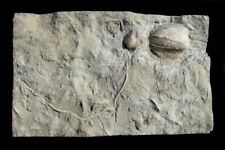When you click on links to various merchants on this site and make a purchase, this can result in this site earning a commission. Affiliate programs and affiliations include, but are not limited to, the eBay Partner Network.
This listingis for a really fascinating blastoid specimen in a display jar, including aninfo card providing information about blastoid and the location this specimencame from. This kit is great for avid fossil and mineral specimen collectors orbeginners. It would be a perfect gift set for getting someone interested infossil collecting and science. The 1 centimeter scale cube is for sizecomparison only. It is not included in the sale. The photos are of severaldifferent specimens, but this listings is only for one specimen with an infocard. The photos show multiple specimens to give a representation of thevariety of shapes and colors in these specimens.
I offer ashipping discount for customers who combine their payments for multiplepurchases into one payment! The discount is regular shipping price for thefirst item and just 50 cents for each additional item! To be sure you get yourshipping discount just make sure all the items you want to purchase are in yourcart. sales you win are added to your cart automatically. For any "buyit now" items or second chance offers, be sure to click the "add tocart" button, NOT the "buy it now" button. Once all of youritems are in your cart just pay for them from your cart and the combinedshipping discount should be applied automatically.
I offer amoney back guarantee on every item I sell.If you are not 100% happy with yourpurchase just send me a message to let me know and I will buy back the item foryour full purchase price.
Hi there. Iam selling this really amazing Pentremites Blastoid echinoderm fossil. I boughtit at a gem show in Arizona and it was found in Indiana. It is really amazing,and very detailed. It would be a great idea to have in a classroom for ateacher, or to have as a part of a gem and mineral and fossil collection, Itwas one of the nicest and most detailed ones that I have ever seen. I havenever come across one that looked so complete and perfect. These amazinganimals are related to star fish and urchins (I also sell fossilized urchins:look for my sale)! THE DETAIL OF THESE SPECIMENS IS AMAZING!!! It's really interesting and I hope it finds agood home out there.
Blastoid
From Wikipedia, the free encyclopedia
Jump to navigationJump to search
Blastoids
Temporal range: Ordovician - Permian
PreЄЄOSDCPTJKPgN
Pentremites Glen Dean Fm KY.jpg
Pentremites godoni, a blastoid from the Lower Carboniferous of Illinois.
Scientific classification
Kingdom: Animalia
Phylum: Echinodermata
Subphylum: Blastozoa
Class: Blastoidea
Say, 1825
Orders
Fissiculata
Spiraculata
Incertae sedis:
†Macurdablastus
"Blastoidea", from Ernst Haeckel's Art Forms of Nature, 1904
Blastoids (class Blastoidea) are an extinct type of stemmed echinoderm, often referred to as sea buds.[1] They first appear, along with many other echinoderm classes, in the Ordovician period, and reached their greatest diversity in the Mississippian subperiod of the Carboniferous period. However, blastoids may have originated in the Cambrian. Blastoids persisted until their extinction at the end of Permian, about 250 million years ago. Although never as diverse as their contemporary relatives, the crinoids, blastoids are common fossils, especially in many Mississippian-age rocks.
Contents
1 Description
2 Taxonomy
3 References
4 External links
Description
Like most echinoderms, blastoids were protected by a set of interlocking plates of calcium carbonate, which formed the main body, or theca. In life, the theca of a typical blastoid was attached to a stalk or column made up of stacked disc-shaped plates. The other end of the column was attached to the ocean floor by a holdfast, very much like stalked crinoids. The stalk was usually relatively short, and in some species, was absent, with the holdfast being attached directly to the base of the theca.
The mouth was located at the summit of the theca. Radiating like flower petals from the center were five food grooves, or ambulacra. Each ambulacrum had many long, thin, fine structures called brachioles, which were used to trap food particles and bring them to the mouth. Brachioles were delicate structures, and in fossils are not usually preserved in place. A series of five spiracle plates surrounded the star-shaped mouth, which included the anus, mouth and entrances to a set of five complex, folded respiratory organs known as hydrospires. These spiracles prevented mixing of the various fluids. Waste elimination was through the anispiracle, an opening formed by the fusing of anus and adjacent spiracles.
Pentremites godoni, a blastoid from the Lower Carboniferous of Illinois; basal view of theca.
Like crinoids, blastoids were high-level, stalked suspension feeders (feeding mainly on planktonic organisms) that inhabited clear-to-silty, moderately agitated ocean waters from shelf to basin. The food gathering system of blastoids consisted of several types of ambulacra. Food entered the brachiolar ambulacra, was transferred to the side ambulacra through the brachiolar pit, then transferred to the main (median) ambulacra, and finally entered the mouth. Each of these ambulacra was roofed by cover plates. The cover plates of the brachiolar groove were movable and could open, allowing food to enter, or close as needed. Other cover plates may also have been movable.
Taxonomy
See also: List of echinodermata orders
Blastoids are assumed to have evolved from the Cystoids. Blastoids are subdivided into two orders: Fissiculata, which are characterized by direct entrance to the individual hydrospires by way of slits; and Spiraculata, which are characterized by indirect entrance to the hydrospires through canals by way of pores. The earliest blastoid yet found, Macurdablastus from the Middle Ordovician of Tennessee, cannot be classified as either order.








